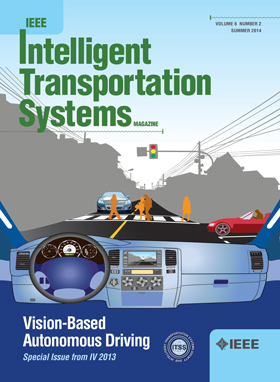基于深度强化学习的车联网内容放置与边缘协同缓存方案
IF 8.4
1区 工程技术
Q1 ENGINEERING, CIVIL
IEEE Transactions on Intelligent Transportation Systems
Pub Date : 2025-04-21
DOI:10.1109/TITS.2025.3558898
引用次数: 0
摘要
随着车联网技术的快速发展,车辆之间的通信和数据交换已成为现代交通管理的重要组成部分。针对车联网系统面临的数据处理和存储挑战,提出了一种基于深度强化学习的内容放置和边缘协同缓存解决方案。利用智能车辆与路边单元之间的协同缓存,采用深度强化学习方法,寻找并设计车联网边缘的协同缓存解决方案。采用内容分段技术,对内容片段进行预先分割和缓存,减少中心服务器负载和网络压力,从而适应车辆移动性和通信时长的随机性。实验结果表明,该方案能够有效降低中心服务器的负载,降低网络时延,提高缓存命中率,为车联网系统的实时通信和数据交换提供灵活高效的解决方案。本文章由计算机程序翻译,如有差异,请以英文原文为准。
Content Placement and Edge Collaborative Caching Scheme Based on Deep Reinforcement Learning for Internet of Vehicles
With the rapid development of Internet of Vehicles technology, communication and data exchange between vehicles have become an important part of modern traffic management. A content placement and edge collaborative caching solution based on deep reinforcement learning is proposed in this paper, aiming to address the data processing and storage challenges faced by Internet of Vehicles systems. Utilizing the collaborative caching between smart vehicles and roadside units employs deep reinforcement learning methods to find and design a collaborative caching solution for the Internet of Vehicles edge. It uses content segmentation technology to divide and cache content fragments in advance to reduce the central server load and network pressure, thereby adapting to the randomness of vehicle mobility and communication duration. The experimental results show that the proposed scheme can effectively reduce the load on the central server, reduce network latency, and improve cache hit rate, providing a flexible and efficient solution for real-time communication and data exchange in the Internet of Vehicles system.
求助全文
通过发布文献求助,成功后即可免费获取论文全文。
去求助
来源期刊

IEEE Transactions on Intelligent Transportation Systems
工程技术-工程:电子与电气
CiteScore
14.80
自引率
12.90%
发文量
1872
审稿时长
7.5 months
期刊介绍:
The theoretical, experimental and operational aspects of electrical and electronics engineering and information technologies as applied to Intelligent Transportation Systems (ITS). Intelligent Transportation Systems are defined as those systems utilizing synergistic technologies and systems engineering concepts to develop and improve transportation systems of all kinds. The scope of this interdisciplinary activity includes the promotion, consolidation and coordination of ITS technical activities among IEEE entities, and providing a focus for cooperative activities, both internally and externally.
 求助内容:
求助内容: 应助结果提醒方式:
应助结果提醒方式:


